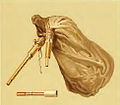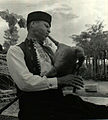Bagpipes
This articleneeds additional citations forverification.(November 2017) |
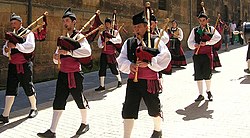 Bagpipers fromAsturias | |
| Woodwind instrument | |
|---|---|
| Classification |
|
| Hornbostel–Sachs classification | 422.112 (Reed aerophonewith conical bore) |
| Related instruments | |
| Musicians | |
Bagpipesare awoodwind instrumentusing enclosedreedsfed from a constant reservoir of air in the form of a bag. TheGreat Highland bagpipesare well known, but people have played bagpipes for centuries throughout large parts ofEurope,Northern Africa,Western Asia,around thePersian Gulfand northern parts ofSouth Asia.
The termbagpipeis equally correct in the singular or the plural, though pipers usually refer to the bagpipes as "the pipes", "a set of pipes" or "a stand of pipes".[1][2]
Construction
[edit]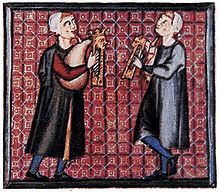
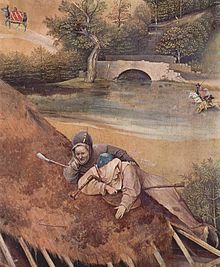
A set of bagpipes minimally consists of an air supply, a bag, achanter,and usually at least onedrone.Many bagpipes have more than one drone (and, sometimes, more than one chanter) in various combinations, held in place in stocks—sockets that fasten the various pipes to the bag.
Air supply
[edit]The most common method of supplying air to the bag is through blowing into a blowpipe or blowstick. In some pipes the player must cover the tip of the blowpipe with the tongue while inhaling, in order to prevent unwanted deflation of the bag, but most blowpipes have a non-return valve that eliminates this need. In recent times, there are many instruments that assist in creating a clean air flow to the pipes and assist the collection of condensation.
The use of abellowsto supply air is an innovation dating from the16thor17thcentury. In these pipes, sometimes called "cauld wind pipes",air is not heated or moistened by the player's breathing, so bellows-driven bagpipes can use more refined or delicate reeds. Such pipes include the Irishuilleann pipes;theborder or Lowland pipes,Scottish smallpipes,Northumbrian smallpipesandpastoral pipesin Britain; themusette de cour,themusette bechonnetand thecabrettein France; and theDudy,koziol bialy,andkoziol czarnyin Poland.
Bag
[edit]The bag is an airtight reservoir that holds air and regulates its flow via arm pressure, allowing the player to maintain continuous, even sound. The player keeps the bag inflated by blowing air into it through a blowpipe or by pumping air into it with a bellows. Materials used for bags vary widely, but the most common are the skins of local animals such as goats, dogs, sheep, and cows. More recently, bags made of synthetic materials includingGore-Texhave become much more common. Some synthetic bags havezipsthat allow the player to fit a more effective moisture trap to the inside of the bag. However, synthetic bags still carry a risk of colonisation by fungal spores, and the associated danger of lung infection if they are not kept clean, even if they otherwise require less cleaning than do bags made from natural substances.
Bags cut from larger materials are usuallysaddle-stitchedwith an extra strip folded over the seam and stitched (for skin bags) or glued (for synthetic bags) to reduce leaks. Holes are then cut to accommodate the stocks. In the case of bags made from largely intact animal skins, the stocks are typically tied into the points where the limbs and the head joined the body of the whole animal, a construction technique common inCentral Europe.Different regions have different ways of treating the hide. The simplest methods involve just the use of salt, while more complex treatments involvemilk,flour,and the removal of fur. The hide is normally turned inside out so that the fur is on the inside of the bag, as this helps to reduce the effect of moisture buildup within the bag.
Chanter
[edit]
The chanter is themelodypipe, played with two hands. All bagpipes have at least one chanter; some pipes have two chanters, particularly those in North Africa, in the Balkans, and in Southwest Asia. A chanter can be bored internally so that the inside walls are parallel (or "cylindrical" ) for its full length, or it can be bored in a conical shape. Popular woods includeboxwood,cornel,plum or other fruit wood.
The chanter is usually open-ended, so there is no easy way for the player to stop the pipe from sounding. Thus most bagpipes share a constantlegatosound with norestsin the music. Primarily because of this inability to stop playing, technical movements are made to break up notes and to create the illusion of articulation and accents. Because of their importance, these embellishments (or "ornaments" ) are often highly technical systems specific to each bagpipe, and take many years of study to master. A few bagpipes (such as the musette de cour, theuilleann pipes,the Northumbrian smallpipes, thepivaand the left chanter of thesurdelina) have closed ends or stop the end on the player's leg, so that when the player "closes" (covers all the holes), the chanter becomes silent.
Apractice chanteris a chanter without bag or drones and has a much quieter reed, allowing a player to practice the instrument quietly and with no variables other than playing the chanter.
The termchanteris derived from the Latincantare,or "to sing", much like the modern French verb meaning "to sing",chanter.
A distinctive feature of the gaida's chanter (which it shares with a number of other Eastern European bagpipes) is the "flea-hole" (also known as amumblerorvoicer,marmorka) which is covered by the index finger of the left hand. The flea-hole is smaller than the rest and usually consists of a small tube that is made out of metal or a chicken or duck feather. Uncovering the flea-hole raises any note played by a half step, and it is used in creating themusical ornamentationthat givesBalkan musicits unique character.
Some types of gaida can have a double bored chanter, such as the Serbian three-voiced gajde. It has eight fingerholes: the top four are covered by the thumb and the first three fingers of the left hand, then the four fingers of the right hand cover the remaining four holes.
Chanter reed
[edit]The note from the chanter is produced by areedinstalled at its top. The reed may be asingle(a reed with one vibrating tongue) ordouble reed(of two pieces that vibrate against each other). Double reeds are used with both conical- and parallel-bored chanters while single reeds are generally (although not exclusively) limited to parallel-bored chanters. In general, double-reed chanters are found in pipes of Western Europe while single-reed chanters appear in most other regions.
They are made from reed (arundo donaxorPhragmites),bamboo,orelder.A more modern variant for the reed is a combination of a cotton phenolic (Hgw2082) material from which the body of the reed is made and a clarinet reed cut to size in order to fit the body. These type of reeds produce a louder sound and are not so sensitive to humidity and temperature changes.[3]
Drone
[edit]Most bagpipes have at least onedrone,a pipe that generally is not fingered but rather produces a constant harmonizing note throughout play (usually thetonicnote of the chanter). Exceptions are generally those pipes that have a double-chanter instead. A drone is most commonly a cylindrically bored tube with a single reed, although drones with double reeds exist. The drone is generally designed in two or more parts with a sliding joint so that the pitch of the drone can be adjusted.
Depending on the type of pipes, the drones may lie over the shoulder, across the arm opposite the bag, or may run parallel to the chanter. Some drones have a tuning screw, which effectively alters the length of the drone by opening a hole, allowing the drone to be tuned to two or more distinct pitches. The tuning screw may also shut off the drone altogether. In most types of pipes with one drone, it is pitched two octaves below the tonic of the chanter. Additional drones often add the octave below and then a drone consonant with the fifth of the chanter.
History
[edit]Possible ancient origins
[edit]The evidence for bagpipes prior to the 13th century AD is still uncertain, but several textual and visual clues have been suggested. TheOxford History of Musicposits that a sculpture of bagpipes has been found on aHittiteslab atEuyukin Anatolia, dated to 1000 BC. Another interpretation of this sculpture suggests that it instead depicts apan fluteplayed along with afriction drum.[4]
Several authors identify theancient Greekaskaulos(ἀσκόςaskos–wine-skin,αὐλόςaulos– reed pipe) with the bagpipe.[5]In the 2nd century AD,Suetoniusdescribed the Roman emperorNeroas a player of thetibia utricularis.[6]Dio Chrysostomwrote in the 1st century of a contemporary sovereign (possibly Nero) who could play a pipe (tibia,Roman reedpipes similar to Greek and Etruscan instruments) with his mouth as well as by tucking a bladder beneath his armpit.[7]Vereno[who?]suggests that such instruments, rather than being seen as an independent class, were understood as variants on mouth-blown instruments that used a bag as an alternative blowing aid and that it was not until drones were added in the European Medieval era that bagpipes were seen as a distinct class.[citation needed]
Spread and development in Europe
[edit]

In the early part of the second millennium, representation of bagpipes began to appear with frequency in Western European art and iconography. TheCantigas de Santa Maria,written inGalician-Portugueseand compiled inCastilein the mid-13th century, depicts several types of bagpipes.[8]Several illustrations of bagpipes also appear in theChronique dite de Baudoin d’Avesnes,a 13th-century manuscript of northern French origin.[9][10]Although evidence of bagpipes in the British Isles prior to the 14th century is contested, they are explicitly mentioned inThe Canterbury Tales(written around 1380):[11]
A baggepype wel coude he blowe and sowne, /And ther-with-al he broghte us out of towne.
— Canterbury Tales
Bagpipes were also frequent subjects for carvers of wooden choir stalls in the late 15th and early 16th century throughout Europe, sometimes with animal musicians.[12]
Actual specimens of bagpipes from before the 18th century are extremely rare; however, a substantial number of paintings, carvings, engravings, and manuscript illuminations survive. These artefacts are clear evidence that bagpipes varied widely throughout Europe, and even within individual regions. Many examples of early folk bagpipes in continental Europe can be found in the paintings of Brueghel, Teniers, Jordaens, and Durer.[13]
The earliest known artefact identified as a part of a bagpipe is a chanter found in 1985 atRostock,Germany, that has been dated to the late 14th century or the first quarter of the 15th century.[14]

The first clear reference to the use of the ScottishHighland bagpipesis from a French history that mentions their use at theBattle of Pinkiein 1547.George Buchanan(1506–82) claimed that bagpipes had replaced the trumpet on the battlefield. This period saw the creation of theceòl mór(great music) of the bagpipe, which reflected its martial origins, with battle tunes, marches, gatherings, salutes and laments.[15]The Highlands of the early 17th century saw the development of piping families including theMacCrimmonds,MacArthurs,MacGregors,and the Mackays ofGairloch.[16]
The earliest Irish mention of the bagpipe is in 1206, approximately thirty years after the Anglo-Norman invasion;[17]another mention attributes their use to Irish troops in Henry VIII'ssiege of Boulogne.[18]Illustrations in the 1581 bookThe Image of IrelandebyJohn Derrickeclearly depict a bagpiper. Derricke's illustrations are considered to be reasonably faithful depictions of the attire and equipment of the English and Irish population of the 16th century.[19]
The "Battell" sequence fromMy Ladye Nevells Booke(1591) byWilliam Byrd,which probably alludes to the Irish wars of 1578, contains a piece entitledThe bagpipe: & the drone.In 1760, the first serious study of the Scottish Highland bagpipe and its music was attempted in Joseph MacDonald'sCompleat Theory.A manuscript from the 1730s by aWilliam DixonofNorthumberlandcontains music that fits theborder pipes,a nine-note bellows-blown bagpipe with a chanter similar to that of the modernGreat Highland bagpipe.However, the music in Dixon's manuscript varied greatly from modern Highland bagpipe tunes, consisting mostly of extended variation sets of common dance tunes. Some of the tunes in the Dixon manuscript correspond to those found in the early 19th century manuscript sources ofNorthumbrian smallpipetunes, notably the rare book of 50 tunes, many with variations, byJohn Peacock.

As Western classical music developed, both in terms of musical sophistication and instrumental technology, bagpipes in many regions fell out of favour because of their limited range and function. This triggered a long, slow decline that continued, in most cases, into the 20th century.
Extensive and documented collections of traditional bagpipes may be found at theMetropolitan Museum of Artin New York City, theInternational Bagpipe MuseuminGijón,Spain, thePitt Rivers MuseuminOxford,England and theMorpeth Chantry Bagpipe Museumin Northumberland, and theMusical Instrument Museumin Phoenix,Arizona.

TheInternational Bagpipe Festivalis held every two years inStrakonice,Czech Republic.
Recent history
[edit]
During the expansion of theBritish Empire,spearheaded by British military forces that includedHighland regiments,the Scottish Great Highland bagpipe became well known worldwide. This surge in popularity was boosted by large numbers of pipers trained for military service inWorld War IandWorld War II.This coincided with a decline in the popularity of many traditional forms of bagpipe throughout Europe, which began to be displaced by instruments from the classical tradition and later by gramophone and radio.
As pipers were easily identifiable, combat losses were high, estimated at one thousand in World War I. A front line role was prohibited following high losses in theSecond Battle of El Alameinin 1943, though a few later instances occurred.
In the United Kingdom andCommonwealth Nationssuch asCanada,New ZealandandAustralia,theGreat Highland bagpipeis commonly used in the military and is often played during formal ceremonies. Foreign militaries patterned after the British army have also adopted the Highland bagpipe, including those ofUganda,Sudan,India,Pakistan,Sri Lanka,Jordan,andOman.Many police and fire services inScotland,Canada, Australia, New Zealand,Hong Kong,and theUnited Stateshave also adopted the tradition of fielding pipe bands.

In recent years, often driven by revivals of native folk music and dance, many types of bagpipes have enjoyed a resurgence in popularity and, in many cases, instruments that had fallen into obscurity have become extremely popular. InBrittany,the Great Highland bagpipe and concept of thepipe bandwere appropriated to create a Breton interpretation known as thebagad.The pipe-band idiom has also been adopted and applied to theGalician gaitaas well. Bagpipes have often been used in various films depicting moments from Scottish and Irish history; the filmBraveheartand the theatrical showRiverdancehave served to make the uilleann pipes more commonly known.
Bagpipes are sometimes played at formal events at Commonwealth universities, particularly in Canada. Because of Scottish influences on the sport ofcurling,bagpipes are also the official instrument of theWorld Curling Federationand are commonly played during a ceremonial procession of teams before major curling championships.
Bagpipe making was once a craft that produced instruments in many distinctive, local and traditional styles. Today, the world's largest producer of the instrument isPakistan,where the industry was worth $6.8 million in 2010.[20][21]In the late 20th century, various models ofelectronic bagpipeswere invented. The first custom-builtMIDIbagpipes were developed by the Asturian piper known asHevia(José Ángel Hevia Velasco).[22]
AstronautKjell N. Lindgrenis thought to be the first person to play the bagpipes inouter space,having played "Amazing Grace"in tribute to late research scientist Victor Hurst aboard theInternational Space Stationin November 2015.[23]
Traditionally, one of the purposes of the bagpipe was to provide music for dancing. This has declined with the growth of dance bands, recordings, and the decline of traditional dance. In turn, this has led to many types of pipes developing a performance-led tradition, and indeed much modern music based on the dance music tradition played on bagpipes is suitable for use as dance music.[citation needed]
Modern usage
[edit]Types of bagpipes
[edit]Numerous types of bagpipes today are widely spread across Europe, the Middle East and North Africa as well as through much of the formerBritish Empire.The name bagpipe has almost become synonymous with its best-known form, theGreat Highland bagpipe,overshadowing the great number and variety of traditional forms of bagpipe. Despite the decline of these other types of pipes over the last few centuries, in recent years many of these pipes have seen a resurgence or revival as musicians have sought them out; for example, theIrish piping tradition,which by the mid 20th century had declined to a handful of master players is today alive, well, and flourishing, a situation similar to that of theAsturian gaita,theGalician gaita,the Portuguesegaita transmontana,theAragonesegaita de boto,Northumbrian smallpipes,theBretonbiniou,theBalkangaida,theRomaniancimpoi,the Black Seatulum,theScottish smallpipesandpastoral pipes,as well as other varieties. Bulgaria has theKaba gaida,a large bagpipe of theRhodope mountainswith a hexagonal and rounded drone, often described as a deep-sounding gaida and the Dzhura gaida with a straight conical drone and of a higherpitch.TheMacedoniangaida is structurally between a kaba and dzhura gaida and described as a medium pitched gaida.
InSoutheastern EuropeandEastern Europebagpipes known asgaidainclude: theAlbanian:gajde, mishnica, bishnica,Aromanian:gaidã,Bulgarian:гайда(gaida),Greek:γκάιντα(gáida)τσαμπούνα(tsaboúna) orασκομαντουρα(askomandoura),Macedonian:гајда(gajda),Serbo-Croatian:gajda/гајда,Turkish:gaydaalsotulumandUkrainian:gayda / ґайда.
In Tunisia, it is known by the name "mezwed".It is used in the Tunisian pop music genre, also calledmezwed,that is named after the instrument.
Image gallery
[edit]
-
Piper in Petrash, Jordan
-
BulgarianKaba gaidaplayer.
-
The Scottish Great Highland bagpipe played at a Canadian military function.
-
A musician with a Northern ItalianBaghètwearing traditional dress.
-
Modern Baghèt (made 2000 by Valter Biella) in G.
-
Central and southern Italianzampogna.
-
Cillian Vallelyplaying Irish Uilleann pipes.
-
Man from Skopje, North Macedonia playing theGaida.
-
Sruti upanga,a Southern Indian bagpipe.
-
Hungarianduda.
-
Serbian piper.
-
Polish pipers.
-
Bagadof Lann Bihoué from the French Navy.
-
Swedishsäckpipa.
-
Pastoral pipeswith removable footjoint and bellows.
-
Street piper from Sofia, Bulgaria.
-
Estoniantorupillplayer.
-
Lithuanian piper.
-
Modern Germanhuemmelchen.
-
Belarusian bagpipes in Lithuanian museum.
-
Welsh bagpipes(double-reed type).
-
Cantabrian pipe band.
-
Syrian piper in Damascus, Syria.
-
Various forms of theTsampouna,found in the Greek islands.
-
Belarusian piper.
-
MalteseŻaqq.
-
Piper playing by theRoyal Palace of Amsterdam.
-
Romaniancimpoiplayer.
-
Ľubomír Párička playing bagpipes, Slovak Republic.
-
Portuguese pipers
-
Chanter of bagpipes from Ab Pakhsh
-
Greekshepherdplaying gaida
-
Bulgarian gaida player, a pre-1945 photo. Central State Archive, Sofia
Usage in non-traditional music
[edit]
Since the 1960s, bagpipes have also made appearances in other forms of music, including rock, metal, jazz, hip-hop, punk, and classical music, for example withPaul McCartney's "Mull of Kintyre",AC/DC's "It's a Long Way to the Top (If You Wanna Rock 'n' Roll)",[24]andPeter Maxwell Davies's compositionAn Orkney Wedding, with Sunrise.

Publications
[edit]Periodicals
[edit]Periodicals covering specific types of bagpipes are addressed in the article for that bagpipe
- An Píobaire,Dublin: Na Píobairí Uilleann.
- Chanter,The Bagpipe Society.
- The Piping Times,Glasgow: TheCollege of Piping.
- Piping Today,Glasgow: The National Piping Centre.
- Utriculus,Italy:Circolo della Zampogna.
- The Voice,Newark,DL:The Eastern United States Pipe Band Association.
Books
[edit]- Baines, Anthony (Nov 1991),Woodwind Instruments and Their History,Dover Pub,ISBN0-486-26885-3.
- ——— (1995),Bagpipes(3rd ed.), Pitt Rivers Museum, Univ. of Oxford,ISBN0-902793-10-1,147 pp. with plates.
- Cheape, Hugh,The Book of the Bagpipe.
- Collinson, Francis (1975),The Bagpipe, The History of a Musical Instrument.
- Vereno, Michael Peter (2021),The Voice of the Wind: A Linguistic History of Bagpipes,International Bagpipe Organisation,ISBN978-1838369804.
See also
[edit]- List of bagpipes
- List of bagpipers
- List of pipe makers
- List of pipe bands
- Glossary of bagpipe terms
- Practice chanter
- Glen (music company)
References
[edit]- ^Wright, J.The English dialect dictionary.Рипол Классик.ISBN9785878652940– via Google Books.
- ^"Unknown #33".
- ^"gaida (bagpipe) in Greece: γκάιντα στην Ελλάδα: gaida (Dudelsack) in Griecheland: gaida Yunanistan'da".www.gaida.gr.Retrieved2016-01-24.
- ^Vereno, Michael Peter. 2021. The Voice of the Wind. Lincoln: International Bagpipe Organisation. pp 14–15
- ^Flood, William Henry Grattan.The story of the bagpipe.Рипол Классик.ISBN9781176344228– via Google Books.
- ^"Life of Nero,54 ",Suetonius, The Lives of the Caesars,Loeb Classical Library,p. 185,retrieved2013-01-02
- ^"Discourses by Dio Chrysostom (Or. 71.9)",The Seventy-first Discourse: On the Philosopher (Volume V),vol. V,Loeb Classical Library,p. 173,retrieved2013-01-02
- ^Aubrey, Elizabeth (1996),The Music of the Troubadours,Indiana University Press,ISBN978-0-253-21389-1,retrieved2013-01-02
- ^Chronique dite de Baudoin d'Avesnes, Arras, BM, ms. 0863, f. 007, 126v, 149v
- ^"Hybride jouant de la cornemuse".Sorbonne, Paris. Archived fromthe originalon 2017-01-10.Retrieved2017-01-09.
- ^Chaucer, Geoffrey,The Canterbury Tales: Prologue to "The Miller's Tale" (line 565),retrieved2013-01-02
- ^"Cochon jouant de la cornemuse".Sorbonne, Paris. Archived fromthe originalon 2017-01-10.Retrieved2017-01-09.
- ^The Great Highland Bagpipes (an piob-mhor),The Northport Pipe Band, NY, archived fromthe originalon February 11, 2013,retrieved2013-01-02
- ^"The Rostock Chanter".www.bagpipesociety.org.uk.Retrieved2021-06-06.
- ^J. E. A. Dawson,Scotland Re-Formed, 1488–1587(Edinburgh: Edinburgh University Press, 2007),ISBN0-7486-1455-9,p. 169.
- ^J. Porter, "Introduction" in J. Porter, ed.,Defining Strains: The Musical Life of Scots in the Seventeenth Century(Peter Lang, 2007),ISBN3-03910-948-0,p. 35.
- ^"The Concise History of the Bagpipe by Frank J. Timoney | Ireland".
- ^Donnelly, Seán, The Early History of Piping in Ireland (2001), p. 9
- ^Derrick, John (1581),The Image of Irelande,London
- ^Jaine, Caroline (2011-10-04),Doing business with Pakistan,Dawn,retrieved2013-02-02
- ^Abbas, Nosheen (2012-12-31)."The thriving bagpipe business of Pakistan".BBC News Online.Pakistan.Retrieved2013-01-02.
- ^Roza-Vigil, Susana (1999-11-05),Bagpipes resonate through rugged coastline of... Spain,WorldBeat, Spain: CNN,retrieved2013-01-02
- ^"Astronaut plays bagpipes on International Space Station".BBC News.7 November 2015.Retrieved30 September2021.
- ^Liming, Sheila (July 9, 2016)."Bagpipes: a rock-and-roll history".Atlantic Monthly.Retrieved13 December2022.
Bibliography
[edit]- Garaj, Bernard (1995).Gajdy a gajdošská tradícia na Slovensku. Bagpipe and Bagpipers´ Tradition in Slovakia.ASCO Ústav hudobnej vedy SAV Bratislava.
- Dzimrevski, Borivoje (1996).Gajdata vo Makedonija: Instrument-instrumentalist-muzika.Institut za folklor Marko Cepenkov.ISBN978-9989642098.
- Lommel, Arle. "The Hungarian Duda and Contra-Chanter Bagpipes of the Carpathian Basin."The Galpin Society Journal(2008): 305–321.
- Rice, Timothy (1994).May It Fill Your Soul: Experiencing Bulgarian Music.University of Chicago Press.ISBN978-0226711225.
- Atanasov, Vergilij (2002).The Bulgarian GAIDA/BAGPIPE.Massachusetts: Gaida Studies.ISBN0-9724898-0-0.
- Širola, Božidar (1937).Sviraljke s udarnim jezičkom.Zagreb: JAZU.
- Leibman, Robert.Traditional Songs and Dances from the Soko Banja Area.LP: Selo Records.
- Levy, Mark (1985).The Bagpipe in the Rhodope Mountains of Bulgaria.University of California.
- Jakovljević, Rastko (2012).Marginality and Cultural Identities: Locating the Bagpipe Music of Serbia.PhD Thesis, Durham University.
External links
[edit]- Bagpipe iconography – Paintings and images of the pipes.
- Musiconis Database of Medieval Musical Iconography: Bagpipe.
- A demonstration of rare instruments including bagpipes(archived 12 November 2009)
- The Concise History of the Bagpipeby Frank J. Timoney
- The Bagpipe Society,dedicated to promoting the study, playing, and making of bagpipes and pipes from around the world
- Bagpipes from polish collections (Polish folk musical instruments)
- Bagpipes (local polish name "Koza" ) played by Jan Karpiel-Bułecka(English subtitles)
- Official site of Baghet (bagpipe from North Italy) players.(archived 9 July 2017)
- Celtic Music: Scottish Military Bagpipes.
- The presence of the gaida in Greece













